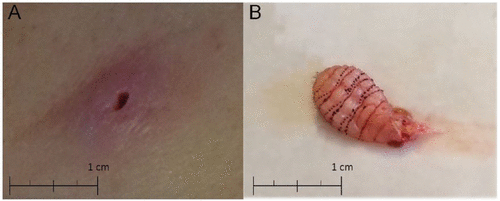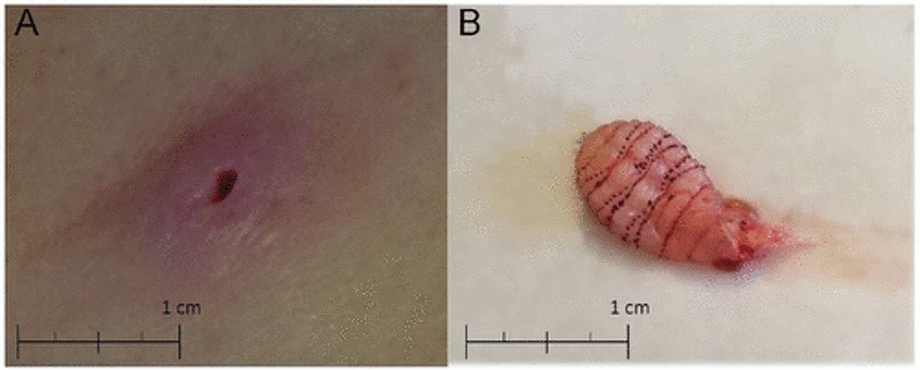-
At left is the lesion created by a human botfly larva (Dermatobia hominid) in order to breathe. Inside was the deeply embedded maggot with rows of spines to prevent the host from removing it easily.
Credit: Mina Shenouda, MD, et al/Journal Investig Med High Case Rep./American Federation for Medical Research/CC by 4.0
less
At left is the lesion created by a human botfly larva (Dermatobia hominid) in order to breathe. Inside was the deeply embedded maggot with rows of spines to prevent the host from removing it easily.
Credit:
… more
Photo: Mina Shenouda, MD, Et Al/Journal Investig Med High Case Rep./American Federation For Medical Research
-
Aaron Dallas of Carbondale, Colo., looks at botfly larvae removed from beneath his scalp in this July 16, 2007, file photo. A doctor found five active bot fly larvae living on Dallas’ head, near the top of his skull, a few weeks after a mosquito apparently placed them there. Dallas said he likely received the larval infestation while on a trip to Belize over the summer. (AP Photo/Post Independent, Kelley Cox) less
Aaron Dallas of Carbondale, Colo., looks at botfly larvae removed from beneath his scalp in this July 16, 2007, file photo. A doctor found five active bot fly larvae living on Dallas’ head, near the top of his … more
Photo: Kelley Cox
-
Photo: Media For Medical/UIG Via Getty
-
MRI
U.S. cost: $1,119
Spain: $130
Switzerland: $503
Australia: $215
>> See the price comparison of medical procedures between the United States and other developed countries around the world…
MRI
U.S. cost: $1,119
Spain: $130
Switzerland: $503
Australia: $215
>> See the price comparison of medical procedures between the United States and other developed countries around the world…
Photo: Media For Medical/UIG Via Getty Images
-
window._taboola = window._taboola || [];
_taboola.push({
mode: ‘thumbnails-c’,
container: ‘taboola-interstitial-gallery-thumbnails-5’,
placement: ‘Interstitial Gallery Thumbnails 5’,
target_type: ‘mix’
});
_taboola.push({flush: true});
-
Hospital birth cost
U.S. cost: $10,808
Spain: $1,950
Switzerland: $7,751
Australia: $5,312
Hospital birth cost
U.S. cost: $10,808
Spain: $1,950
Switzerland: $7,751
Australia: $5,312
Photo: ED SUBA JR., MBR
-
Arthritis medication – 28 day supply of Humira
U.S. cost: $2,669
Spain: $1,253
Switzerland: $822
Australia: N/A
Arthritis medication – 28 day supply of Humira
U.S. cost: $2,669
Spain: $1,253
Switzerland: $822
Australia: N/A
Photo: JB REED, Bloomberg News
-
Hospital Cost per Day
U.S. cost: $5,220
Spain: $424
Switzerland: $4,781
Australia: $765
Hospital Cost per Day
U.S. cost: $5,220
Spain: $424
Switzerland: $4,781
Australia: $765
Photo: Mark Mulligan, Mark Mulligan / Houston Chronicle
-
HIV/AIDS medication – 30 day supply of Truvada
U.S. cost: $1,301
Spain: $559
Switzerland: $906
Australia: N/A
HIV/AIDS medication – 30 day supply of Truvada
U.S. cost: $1,301
Spain: $559
Switzerland: $906
Australia: N/A
Photo: Astrid Riecken
-
window._taboola = window._taboola || [];
_taboola.push({
mode: ‘thumbnails-c’,
container: ‘taboola-interstitial-gallery-thumbnails-10’,
placement: ‘Interstitial Gallery Thumbnails 10’,
target_type: ‘mix’
});
_taboola.push({flush: true});
-
Colonoscopy
U.S. cost: $1,301
Spain: $589
Switzerland: $604
Australia: $372
Colonoscopy
U.S. cost: $1,301
Spain: $589
Switzerland: $604
Australia: $372
Photo: (Bobbi Gruner)
-
Hip Replacement
U.S. cost: $29,067
Spain: $6,757
Switzerland: $17,112
Australia: $19,484
Hip Replacement
U.S. cost: $29,067
Spain: $6,757
Switzerland: $17,112
Australia: $19,484
Photo: BSIP/UIG Via Getty Images
-
Cancer treatment drug – 400 mg vial of Avastin
U.S. cost: $3,930
Spain: $1,534
Switzerland: $1,752
Australia: N/A
Cancer treatment drug – 400 mg vial of Avastin
U.S. cost: $3,930
Spain: $1,534
Switzerland: $1,752
Australia: N/A
Photo: DAVID GRUBBS, AP
-
Bypass Surgery
U.S. cost: $78,318
Spain: $14,579
Switzerland: $34,224
Australia: $28,888
Bypass Surgery
U.S. cost: $78,318
Spain: $14,579
Switzerland: $34,224
Australia: $28,888
Photo: William F. Campbell/The LIFE Images Collection/Getty Images
-
window._taboola = window._taboola || [];
_taboola.push({
mode: ‘thumbnails-c’,
container: ‘taboola-interstitial-gallery-thumbnails-15’,
placement: ‘Interstitial Gallery Thumbnails 15’,
target_type: ‘mix’
});
_taboola.push({flush: true});
-
Abdominal CT Scan
U.S. cost: $844
Spain: $85
Switzerland: $383
Australia: N/A
Abdominal CT Scan
U.S. cost: $844
Spain: $85
Switzerland: $383
Australia: N/A
Photo: Mayra Beltran, Houston Chronicle
-
Cardiac Catheterization
U.S. cost: $5,061
Spain: $2,974
Switzerland: $181
Australia: $487
Cardiac Catheterization
U.S. cost: $5,061
Spain: $2,974
Switzerland: $181
Australia: $487
Photo: Associated Press
-
Painkiller – 30+ day supply of OxyContin
U.S. cost: $265
Spain: $36
Switzerland: $95
Australia: N/A
Painkiller – 30+ day supply of OxyContin
U.S. cost: $265
Spain: $36
Switzerland: $95
Australia: N/A
Photo: Toby Talbot, Associated Press
-
Appendectomy – Removal of the appendix
U.S. cost: $15,930
Spain: $2,003
Switzerland: $6,040
Australia: $3,814
Appendectomy – Removal of the appendix
U.S. cost: $15,930
Spain: $2,003
Switzerland: $6,040
Australia: $3,814
Photo: UniversalImagesGroup/UIG Via Getty Images
-
window._taboola = window._taboola || [];
_taboola.push({
mode: ‘thumbnails-c’,
container: ‘taboola-interstitial-gallery-thumbnails-20’,
placement: ‘Interstitial Gallery Thumbnails 20’,
target_type: ‘mix’
});
_taboola.push({flush: true});
-
U.S. cost: $16,106
Spain: $2,352
Switzerland: $9,965
Australia: $7,901
U.S. cost: $16,106
Spain: $2,352
Switzerland: $9,965
Australia: $7,901
Photo: Ryan Grassley, HONS
-
Cataract Surgery
U.S. cost: $3,530
Spain: $1,719
Switzerland: $2,114
Australia: $3,037
Cataract Surgery
U.S. cost: $3,530
Spain: $1,719
Switzerland: $2,114
Australia: $3,037
Photo: Connor Radnovich, The Chronicle
-
Knee Replacement
U.S. cost: $28,184
Spain: $6,687
Switzerland: $20,132
Australia: $15,941
Knee Replacement
U.S. cost: $28,184
Spain: $6,687
Switzerland: $20,132
Australia: $15,941
Photo: Photo Provided
-
window._taboola = window._taboola || [];
_taboola.push({
mode: ‘thumbnails-c’,
container: ‘taboola-interstitial-gallery-thumbnails-24’,
placement: ‘Interstitial Gallery Thumbnails 24’,
target_type: ‘mix’
});
_taboola.push({flush: true});
Photo: Mina Shenouda, MD, Et Al/Journal Investig Med High Case Rep./American Federation For Medical Research
At left is the lesion created by a human botfly larva (Dermatobia hominid) in order to breathe. Inside was the deeply embedded maggot with rows of spines to prevent the host from removing it easily.
Credit: Mina Shenouda, MD, et al/Journal Investig Med High Case Rep./American Federation for Medical Research/CC by 4.0
less
At left is the lesion created by a human botfly larva (Dermatobia hominid) in order to breathe. Inside was the deeply embedded maggot with rows of spines to prevent the host from removing it easily.
Credit:
… more
Photo: Mina Shenouda, MD, Et Al/Journal Investig Med High Case Rep./American Federation For Medical Research
Mystery wound in honeymooner’s groin was ‘deeply embedded maggot’
A bride who spent her honeymoon in Belize returned to her Florida home with more than just lovely memories of Mayan ruins and crystal-clear Caribbean lagoons.
Little did she know that she had picked up a bug during the trip.
The Journal of Investigative Medicine High Impact Case Reports wrote about the skin-crawling case earlier this month.
The 36-year-old woman didn’t notice anything out of the ordinary for two months. But what she thought was a pimple on the left side of her groin began to itch. An insect bite seemed possible, so she went to see her doctor, who thought it was likely a spider had bitten her and the wound had become infected.
But the prescribed antibiotics didn’t solve the problem. So she sought a second opinion.
According to LiveScience, Dr. Enrico Camporesi, a specialist in wound healing at Memorial Hospital in Tampa, Fla., found that the skin around the lesion, which was now leaking pus, was hard as if there were a bean or pebble underneath it. He was worried that it could be a lymph node infection, but a surgeon he consulted had a different theory — that the lump was a living creature.
Sure enough, surgery revealed a “deeply embedded maggot” with a tapered shape and rows of spines and hooks.
MORE: Florida man dies from eating oyster tainted with flesh-eating bacteria
It was the larva of a human botfly, an insect common to Central and South America. When human botfly eggs hatch, the tiny larvae can burrow into human skin and make themselves comfortable, feeding on skin tissue and flesh. A hole forms so that the baby insect can breath, expanding as the fly grows.
“In some cases, the patients can feel the larvae moving when they shower or cover the wound,” the case study notes.
After 27 to 128 days, the larva drops to the ground where it pupates, eventually maturing into an adult botfly, roughly the size of a bumblebee.
In countries where botflies are common, such infestations are nipped in the bud by smearing petroleum jelly or another substance to block the hole and suffocate the larva.
Naturally, the Florida patient was disturbed to learn a insect was growing under her skin, but following its extraction, her wound healed completely in about a week.



















